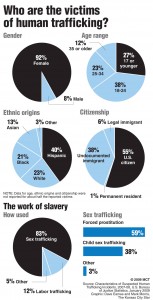Marie (not her real name) was a 15-year-old girl like many others – she was a soccer player who worked hard in her classes and had dreams of going to college to become a nurse. Unlike many students, though, she had a secret.
At home Marie’s stepfather abused her on a regular basis, and after several years of sexual and physical trauma she became too afraid to stand up to him. Her solution was to run away from her family’s home in Eastlake.
“I couldn’t tell my mother because I knew it was gonna break her heart, and I was embarrassed to talk to anyone at school about it,” Marie said. “I got up and left and thought that I’d finally be safe.”
Instead of the safety she thought she was running away to, Marie instead found herself alone and hungry on the streets in downtown San Diego, wondering where she would turn next. When Bruce (also a pseudonym) asked her out to dinner, offering to pay, she gladly accepted. She and the 32-year-old immediately started dating, but within a few short weeks he revealed his plan to her for how they could make some quick cash: prostitution.
Having no other options, she reluctantly decided to go along with his idea, but Marie soon realized that the emotional turmoil would be more than she could bear.
“The first time was the hardest,” Marie said. “I kept thinking that it was wrong. This man was dirty, sweating, groping me, focused on getting laid and nothing else. I went back to Bruce’s apartment and cried myself to sleep, saying I wouldn’t do it again, but the next night I was back on the street.”
America’s Finest City is the eighth most prominent U.S. metro area for sex trafficking, according to the FBI (Los Angeles and San Francisco are also in the top 13). It is estimated that as many as 2,500 teenage runaways are in San Diego at any given time, and that most runaway children are approached for sex within 48 hours of being on their own, according to Generate Hope’s Director of Development Holly Hepburn.
Since 2010, Generate Hope – a San Diego non-profit organization – has been working with women ages 18 to 35 who are victims of sex trafficking, helping them break free from trafficking and reestablish themselves in mainstream society. Although Generate Hope helps victims from all areas, the majority are from San Diego County.
“It’s very much happening in our cities and in our schools,” Hepburn said about sex trafficking-related crimes.
Eric Drilling, a vice detective in the San Diego Police Department, said the average age for entering into prostitution is 12 to 13. He said that most local victims of sex trafficking are from the San Diego area.
Drilling said people might see girls working on streets known for prostitutes, such as El Cajon Boulevard, and think they are there freely, but that this is often a misconception.
“A vast majority of these girls have pimps, and it may appear that they’re willing to do this, but there’s a lot of psychological coercion that goes into pimping,” Drilling said.
The Californians Against Sexual Exploitation Act, also known as Proposition 35, is an initiative to fight sex trafficking in California, will be on the ballot Tuesday. If passed, the so-called CASE Act would increase Megan’s Law protections against online predators, increase prison terms for those convicted of sex trafficking and require that law enforcement agents have sufficient training on human trafficking.
The CASE Act would also create fines for convicted criminals. Funds raised from the fines would be used in services to help sex trafficking victims.
“I think it’s a good starting point because you’ve got to start somewhere,” Hepburn said about the CASE Act. “It’s a tough subject [and] it’s going to be tough to get [the law] passed. People are just starting to learn about it.”
Drilling believes changes in the law such as Prop 35 and increased funding for law enforcement are key to fighting sex trafficking.
“I’m a cop. I’m always going to advocate for more money,” he said. “We could double the size of this [vice] unit, and it just means that many more girls off the street and that many more pimps in jail. Sentencing is something that certainly assists us with the goal of locking away people that engage in this activity.”
Marie finally got away from Bruce and selling her body, yet many more victims of sex trafficking remain in San Diego. Today, Marie has escaped from both the trauma of her abusive upbringing and the abusive lifestyle of working for Bruce, but many children are still trapped within abusive relationships
“I wish that there were options for me when I was being abused by my stepdad,” Marie said. “Other kids [shouldn’t have to] sell their bodies like I did at that age, and I hope that things change so girls can escape from [sex] trafficking easier.”

